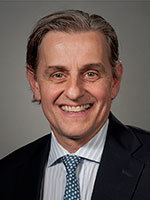Nationality American Role Researcher Name Kevin Tracey | Known for Bioelectronics | |
 | ||
Institutions Feinstein Institute for Medical Research Books Fatal Sequence: The Killer Within Education | ||
Kevin j tracey on the value of innovation hofstra north shore lij school of medicine
Kevin J. Tracey, a neurosurgeon and inventor, is the president and CEO of the Feinstein Institute for Medical Research, professor of neurosurgery and molecular medicine at Hofstra North Shore LIJ School of Medicine, and President of the Elmezzi Graduate School of Molecular Medicine in Manhasset, New York.
Contents
- Kevin j tracey on the value of innovation hofstra north shore lij school of medicine
- Kevin J Tracey Bioelectronic Medicine Feinstein Institute
- Early life
- Academic appointments
- Research
- Awards and honors
- Book and editorial activities
- References
Kevin J Tracey, Bioelectronic Medicine, Feinstein Institute
Early life
Tracey was born in Fort Wayne, Indiana on 10 December 1957. He received his B.S. in chemistry summa cum laude from Boston College in 1979 and his M.D. from Boston University in 1983. From 1983 to 1992 he trained in neurosurgery at the New York Hospital/Cornell University with Russel Patterson. During this time he was also a guest investigator at Rockefeller University.
Academic appointments
In 1992, Tracey moved to the North Shore-LIJ Health System, in Manhasset, New York, where he practiced neurosurgery and established the Laboratory of Biomedical Science. In 2005 he was appointed president and CEO of the Feinstein Institute for Medical Research, and professor at and president of the Elmezzi Graduate School of Molecular Medicine (Manhasset, New York). In 2008, North Shore-LIJ partnered with Hofstra University to establish a new school of medicine at Hofstra University.
Research
Tracey studies inflammation, the physiological and immunological response to infection and injury, and worked on the mechanism by which neurons control the immune system.
In the early 1980s, with Stephen Lowry (Cornell University Medical Center) and Anthony Cerami (Rockefeller University), he described the direct inflammatory activity of tumor necrosis factor-alpha (TNF). This was followed by a report that specific anti-TNF monoclonal antibodies can be effectively used as a therapeutic agent.
A subsequently expanding field of research confirmed that TNF is a mediator of septic shock (similar to the effects of directly administering TNF to mammals), but not sepsis. This prompted Tracey to search for another mediator of sepsis, culminating in 1999 with the identification of HMGB1, a protein previously known as a DNA-binding transcription factor, as a mediator and drug target in sepsis.
Reasoning that evolution must have favored physiological mechanisms to maintain homeostasis, Tracey proposed a mechanism for neural control of TNF and HMGB1 to maintain immunological homeostasis. Termed the "inflammatory reflex", action potentials carried in the vagus nerve inhibit cytokine release and innate immunity. The neurophysiological mechanism is dependent upon action potentials transmitted in the vagus nerve which activate release of acetylcholine, a neurotransmitter that interacts with alpha-7 nicotinic receptors expressed on the cell surface of macrophages that produce TNF and other cytokines. The interaction of acetylcholine with alpha-7 nicotinic receptors prevents cytokine release by downregulating nuclear activation of NFkB. Stimulating the vagus nerve inhibits potentially damaging cytokine responses, and protects against organ damage caused by unregulated or excessive cytokine release. In 2011 Tracey and his colleagues Mauricio Rosas-Ballina and Peder Olofsson discovered a memory T cell subset that secretes acetylcholine in the spleen when activated by signals arising in the vagus nerve. These T cells are regulated by incoming neurotransmission arising in the brain stem, and respond by producing the terminal neurotransmitter required to complete the inflammatory reflex.
The neural circuit they discovered can be exploited to therapeutic advantage, because application of electrodes to stimulate the vagus nerve (vagus nerve stimulation) protects against damaging inflammation in experimental arthritis, colitis, ischemia, myocardial infarction, congestive heart failure, and other conditions. The importance of the inflammatory reflex in controlling inflammation establishes the concept that the immune system does not function autonomously, but rather its output is coordinated by physiological units of reflex action. In November 2012, Tracey co-authored the report of the first successful clinical trial demonstrating that vagus nerve stimulation can be effective in methotrexate-resistant rheumatoid arthritis patients, findings that were presented at the annual meeting of the American College of Rheumatology.
Tracey was featured in a "New York Times" Sunday Magazine piece in May 2014, entitled, "Can the Nervous System Be Hacked?" highlighting his role in the advancement of the field of bioelectronic medicine, otherwise known as "bioelectronics".
